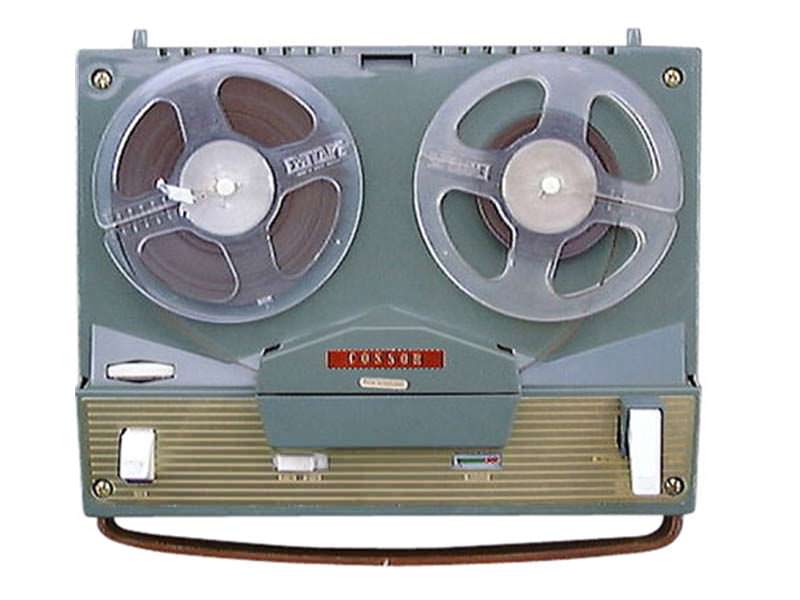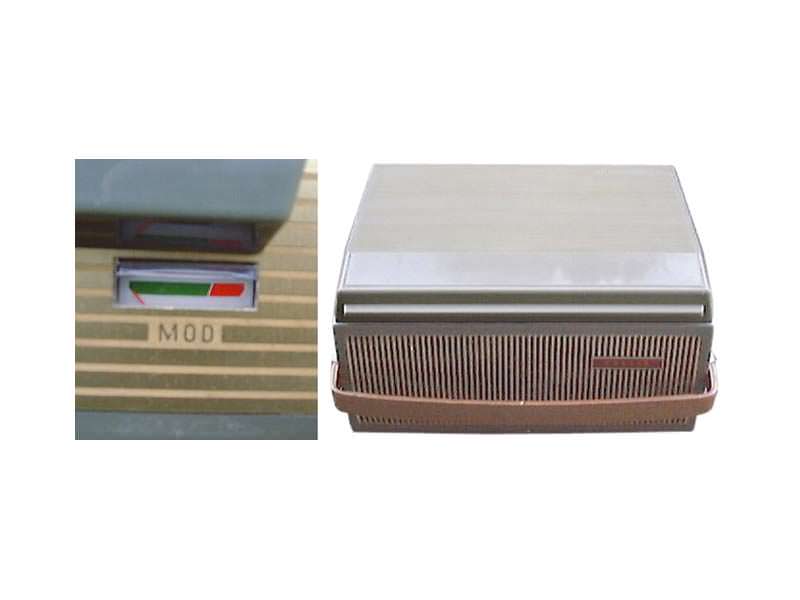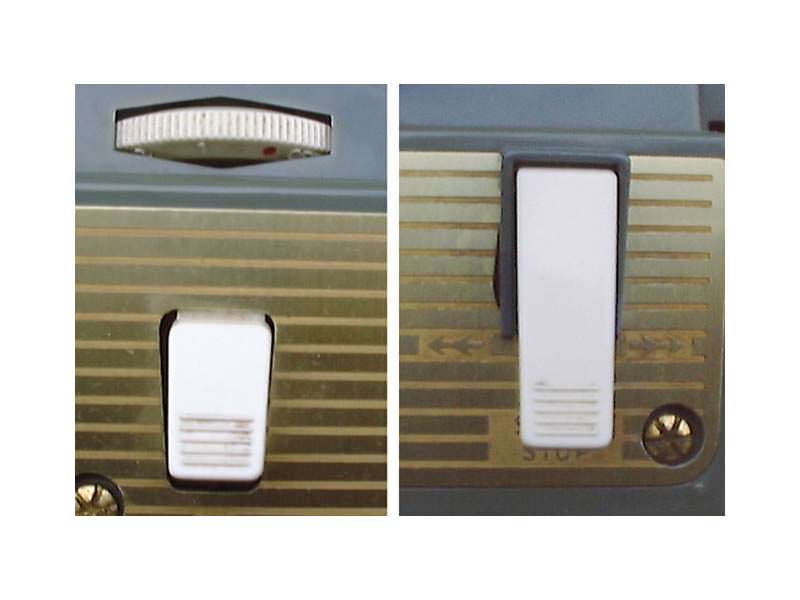Technical Details
Brand: Cossor
Model:CR-1603
Category:Vintage
Application:Consumer
Electronics:Tube
Equalization:IEC
Country of Manufacture:United Kingdom
Release dates:1962 - 1965
Tracks:1/2 Rec/PB
Speeds: 3 3/4
Max Reel Size("): 5"
Number of heads: 2
Head Composition: Permalloy
Head Configuration: Mono - Full Track
# Motors: 1
Auto Reverse?:No
Voltage(s): 220-240v
Outputs: DIN
Frequency Response:80Hz - 13kHz
Sound quality rating:5 / 10
Long-term reliability rating: 5/ 10
Additional Details
Description
This was a low-budget, solid state, quarter-track mono recorder with a single speed of 3¾ ips. Reels of up to 5¾” could be accommodated and a small VU meter was provided, as was a diode input/output socket. An internal 4″ speaker was driven by a 1 watt amplifier.
Price when new in the U.K. was £29 8s complete with moving coil microphone.
Additional Info
Tape Recording Magazine, December 1963
SOMEWHAT to my surprise, I found that this recorder is made in Holland, presumably by the Philips’ side of the organisation. Certainly, the components and style of assembly look very Continental and “Philipsish.” Be that as it may, whoever produced it did a commendable job.
It is a transistorised, AC mains (only) operated , single-speed, four-track machine of simple, uncluttered design and pleasing appearance, tropicalised for world-wide use. The case is made of tough, moulded plastic, in two shades of green, with a strong carrying handle (not detachable) across the front. The removable lid has no hinges, or other fittings fastened to it, all fancy trimmings and catches having been eliminated in favour of a plain moulding, with catches integral. This results in a very neat and unobtrusive job, with nothing to tarnish or rust.
The recorder operates on mains voltages of 110, 127 and 200/250 at 50 or 60 cycles, the consumption being approximately 25 watts. Mains voltage is selected by means of an adjuster mounted underneath the case in a recess which also provides stowage for the three-core mains lead. Accessories supplied consist of a five-inch reel of LP tape, an empty spool, a moving-coil (dynamic) microphone in a hand/desk case with lead and plug, and a fully-illustrated operating handbook. The latter is quite good, but suffers from the common fault of not detailing the pin numbers for connections to the various plugs which results in a tedious process of elimination when wishing to use one’s own accessories
DECK AND CONTROLS
The recorder is switched on by means of an edgewise-mounted knob, in front of the feed spool, which operates both the “on/off” switch and the combined “record/playback” level control. A single motor, which with extra fused windings, doubles as a mains transformer, drives the spools and capstan through idler pulleys and a belt, respectively, giving a fixed tape speed of 3¾ ips. The belt is kept clean by running it through the bristles of a small brush, and 50 or 60 cps operation is obtained by placing the belt in the appropriate slot of a double pulley on the motor spindle.
Any of the four tracks can be used by operating a selector switch to the left front of the head covers and the usual reel inversion procedure. A total playing time of six hours is available when a maximum sized (5¾-inch) reel of DP tape is used. The rear head cover is part of the top moulding, but the front cover is detachable, for head cleaning, etc., the “record/playback” head being fully screened during operation.
To record, a red push–button on the left of the deck is depressed. With the tape stationary the recording level can be set by means of a moving–coil meter to the right of the track switch. The tape is then started by holding down the red button and depressing a lever switch on the right of the deck. This switch is depressed for playback only, and rotated to left or right, with its mounting bracket, for fast winding. Although not particularly fast, rewind does give a smooth, firm reel. Braking is positive and there is no tape spillage or looping.
CONNECTIONS AND AMPLIFIER
The following connections are made to four sockets on a panel on the left-hand side of the recorder:–
(a) Microphone input: sensitivity 400 microvolts at 1,500 ohms impedance.
(b) Radio input: sensitivity 2.0 mV at 20 Kilohms impedance and on the same socket, output to external amplifier; 1.5 v max. at the same impedance.
(c) Pick–up input: sensitivity 100 mV at 680 Kilohms impedance.
(d) External loudspeaker: impedance 3 to 7 ohms.
The amplifier is transistorised and has a claimed frequency response of 80 to 13,000 cps ±3 dB, at an output power of 700 mW. This is fed to a four-inch round p.m. loudspeaker on the front of the case. A printed circuit panel, mounted immediately behind the sockets, carries the amplifier components, giving the interior a clean–and half-empty!)–appearance and improving the accessibility for maintenance. The compact assembly is adequately screened, resulting in a very low level of hum and noise, in spite of the high sensitivity on the microphone channel.
OPERATION AND PERFORMANCE
There is little to be said about the operation of the recorder. There are so few controls that operation is simplicity itself! Every possible aspect is covered by the handbook so that it would seem to be the ideal machine for anyone who requires only to make an acceptable recording with the absolute minimum of fuss.
Performance figures for the microphone alone are not given, but it is very sensitive and produces a pleasant, natural sound, free from any objectionable peaks or resonances. Even music recorded through it had a surprisingly lifelike quality. Recording on other input signals, too, results in a playback signal free from wow, noise and hum provided that leads are properly screened and the quality of reproduction when external amplifiers and/or loudspeakers are used is truly enjoyable.
There is no doubt that the long struggle made by the conscientious manufacturers to achieve the best possible reproduction, is now really paying dividends and some of the smaller modern recorders are as good as one would have expected semi–professional models to be, only a few years ago. This one is a little beauty and I would recommend it unhesitatingly as a good domestic machine.
Access to the works is easy, top or bottom, when routine maintenance is required. Only the lever switch need be removed–and that just pulls off. One small snag, however (all these things seem to have “one small snag ” !) when removing the top half of the case, the record-level meter does not remain behind on the chassis, as in some of the larger machines. It comes up with the cover. The leads are solid, not stranded flexible, and they break when the cover is turned over. I know. I broke ’em! Please, manufacturers, don’t use solid wire for movable fittings–or, better still, don’t move the bits. Fix them to the chassis where they’ll stay put when doing the odd cleaning and oiling job, etc. Nothing is more annoying than having lumps hanging.
Since the above is just a plea to make the serviceman’s life a happier one, and most of you will probably not want to see inside your recorder for years on end (modern lubrication being almost permanent), the comment is not intended as a deterrent. The recorder will, I’m sure, give lots of reliable fun to all future purchasers and is, in my opinion at its selling price of 28 guineas, one of the best bargains on the market today.
Manufacturer’s Specifications
Supply: Mains only, at 110, 127, 200–250 volts, 50 or 60 cps.
Consumption: 25 watts (approx.).
Speed: 3¾ ips.
Recording sense: Four tracks, left to right.
Amplifier: Transistorised. Output: 700 mW.
Loudspeaker: Four–inch diameter, 3 to 7 ohms impedance, p.m.
Frequency response: 80–13,000 cps ±3 dB
Inputs: Microphone 1,500 ohms, 0.4 mV; Radio 20 Kilohms, 2.0 mV; and Pick-up 680 Kilohms, 100.0 mV.
Outputs: Loudspeaker 3–7 ohms; Radio (or extension amplifier) 20 Kilohms, 1.5 v.
Reel size: 5¾ inch maximum.
Manufacturers: Cossor Radio and Television Co. Ltd., 233 Tottenham Court Road, London, W.1.
Alan Beautement




